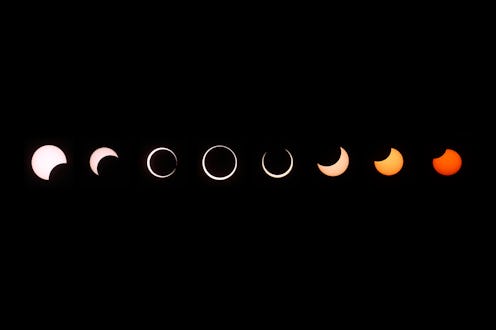The solar eclipse that’s set to occur on Sept. 1, 2016 has everyone all fired up, and with good reason. It’s an annular solar eclipse, which is often referred to as a “ring of fire” eclipse. However, since a lot of us won’t be able to see this one, many are wondering about the frequency of annular solar eclipses. How often do they occur? If we can't see this one, when will we be able to see one? Well, the good news is that they don’t occur that infrequently… but the bad news is that if you’re in North America, it might be a few years before you’ll be able to watch one in person.
You probably already know what an eclipse is, but let’s recap. As Bustle’s Megan Grant recently put it, “An eclipse occurs when one celestial body moves into the shadow of another body.” We usually think of this in terms of the Sun and the Moon, with a solar eclipse occurring when the Moon moves in front of the Sun, thereby blocking the Sun’s light from reaching the Earth. An annular solar eclipse, however — that is, the kind that’s occurring on Sept. 1 — is a specific kind of eclipse. It occurs when the Moon is at its apogee — that is, the furthest away from the Earth it can possibly be. The result, for those who are lucky enough to see it, is a “ring of fire” effect.
Cool, right?
Now, as for how often they occur: Annular solar eclipses aren’t like, say, equinoxes. That is, they don’t happen at roughly the same time every year. While eclipses do generally occur about every six months, it isn’t necessarily the same kind of eclipse each time — and, indeed, it might be dramatically different.
According to Time and Date, annular solar eclipses require a specific set of circumstances in order to occur. They can only happen when the Moon is new, when the Moon is at or near a lunar node and the Earth, Moon, and Sun are perfectly aligned, or when the Moon is at its apogee. Worth noting, though, is that although every annular solar eclipse happens at a new moon, not every new moon is a annular solar eclipse, due to the way the Moon orbits in relation to the Earth.
In general, we see an annular eclipse about every year or two, depending on where all the celestial bodies involved are at in their respective cycles. Here are the dates of the six annular solar eclipses prior to this year’s:
- Feb. 7, 2008
- Jan. 26, 2009
- Jan. 15, 2010
- May 20 - 21, 2012
- May 9 - 10, 2013
- April 29, 2014
And here’s the schedule for the next six annular solar eclipses after 2016's:
- Feb. 26, 2017
- Dec. 26, 2019
- June 21, 2020
- June 10, 2021
- Oct. 14, 2023
- Oct. 2, 2024
However, it’ll be a while before those of us located in the United States will actually be able to witness an annular solar eclipse in action. According to the paths projected by Time and Date, the eclipses occurring in 2017, 2019, and 2020 won’t really be visible from North America. The one occurring in 2021 will be partially visible for part of the United States and for a lot of Canada, though. Furthermore, the one occurring in 2023 will be visible or partially visible in much of the United States. We may have to be a little patient, but at least there’s that, right? And hey, there are always livestreams. Thanks to the wonders of the internet, we can usually observe super cool astronomical events in action even when we can't witness them in person.
Image: Giphy
